Aside from the countless graphics cards in the reference design, Asus offered two models with their own cooler (test) 15 years ago. The EN7600 GT Silent relied on a passive cooler, while the EN7900 GT TOP was actively cooled and operated with significantly increased clock rates.
Table of contents
- 1 Lots of plastic and little space
- There was nothing to complain about in terms of performance
- Conclusion
A lot of plastic and little space
The Asus EN7600GT Silent relies on the G73 GPU with 178 million transistors. This was operated with the standard frequency of 560 MHz. The 256 MB graphics memory also clocked at the 700 MHz specified by Nvidia. The built-in cooler was its own design. A copper plate dissipated the waste heat from the GPU and then via a heat pipe to the aluminum fins. An interesting detail was that the actual heat sink was mounted vertically above the graphics card and could be rotated by 90 ° using a swivel arm. This made it possible to place the heat sink above the CPU cooler in order to be cooled by its fan.
-
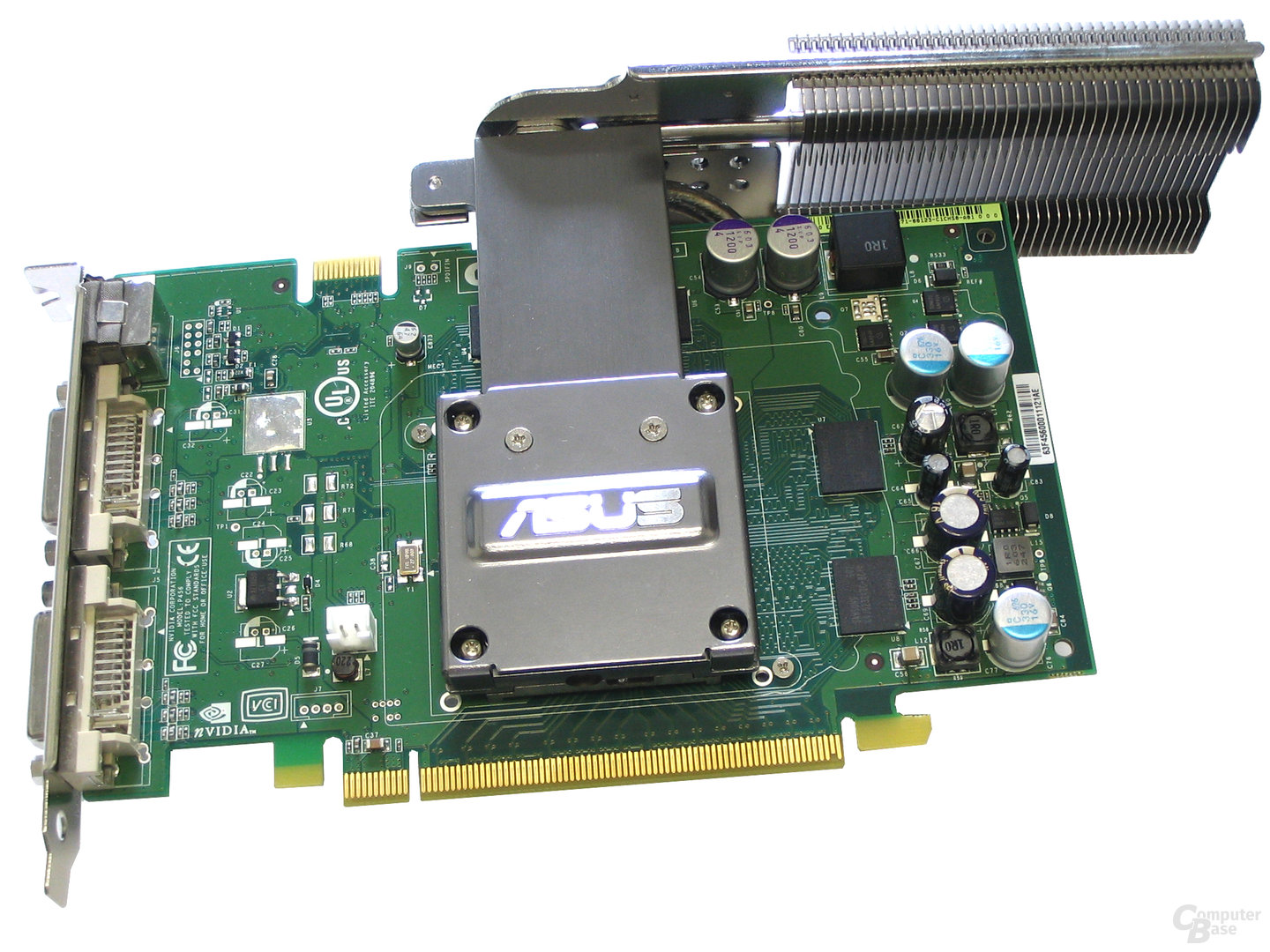 Asus N7600GT Silent
Asus N7600GT Silent
Image 1 of 20
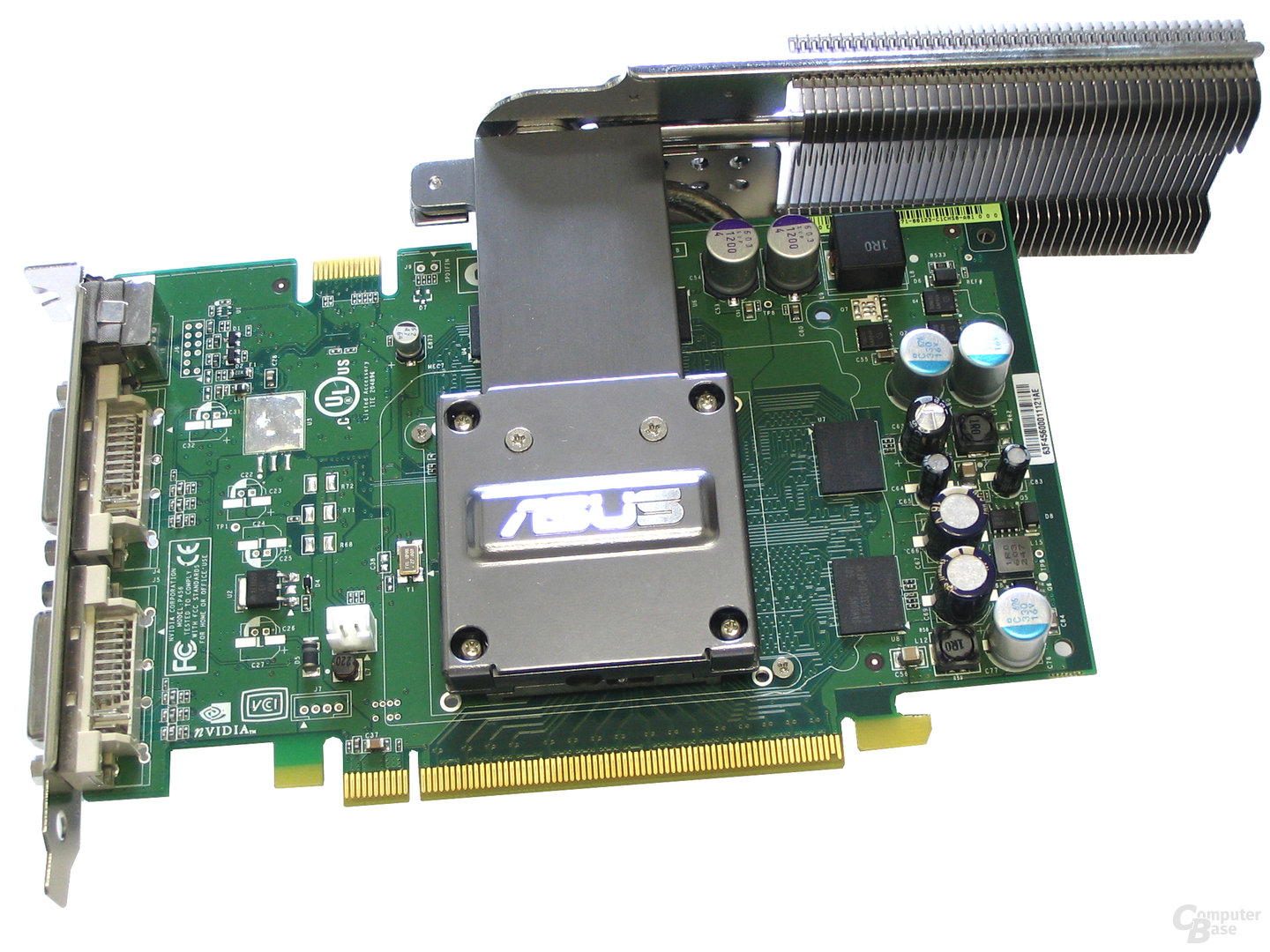 Asus N7600GT Silent
Asus N7600GT Silent  G71-Core
G71-Core 
 Asus N7600GT Silent backside
Asus N7600GT Silent backside 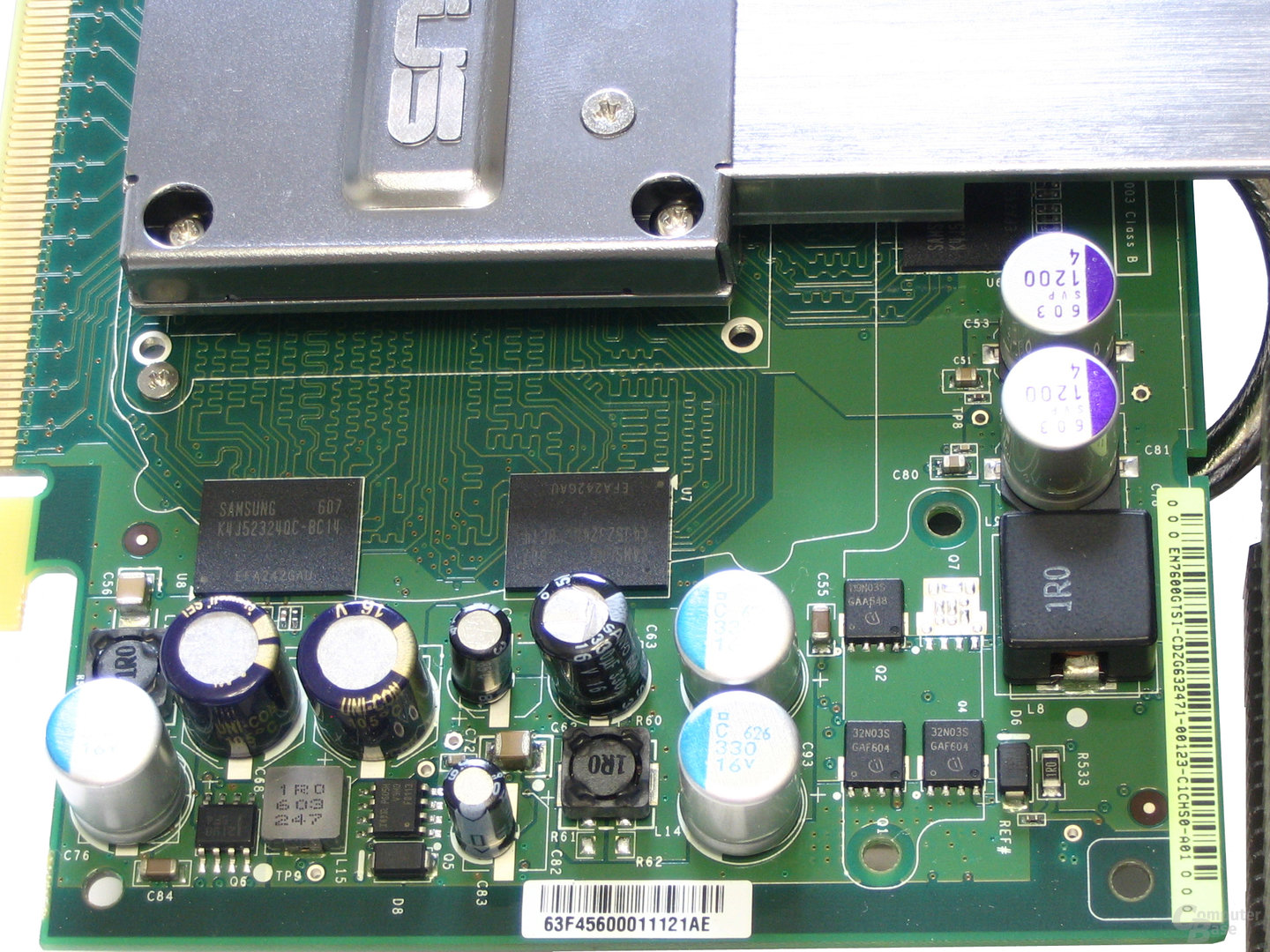 Asus N7600GT Silent voltage converter
Asus N7600GT Silent voltage converter 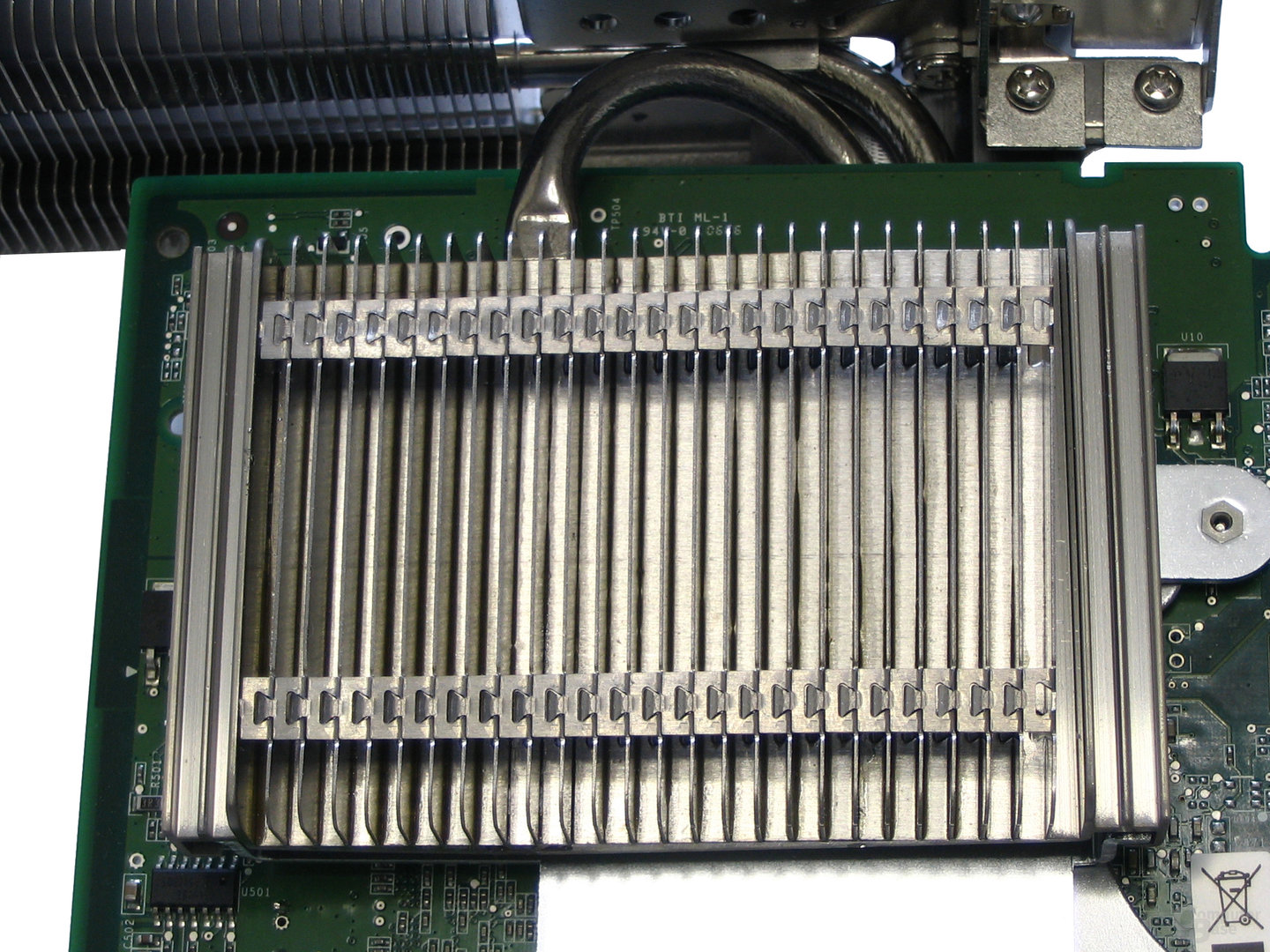 Asus EN7600GT Silent cooler back page
Asus EN7600GT Silent cooler back page  Asus EN7600GTfigure = “/wp-content/uploads/8dac0d143d2e7b42f05a41a22dca653f.jpg” />Asus N7600GT Silent Swivel Arm
Asus EN7600GTfigure = “/wp-content/uploads/8dac0d143d2e7b42f05a41a22dca653f.jpg” />Asus N7600GT Silent Swivel Arm 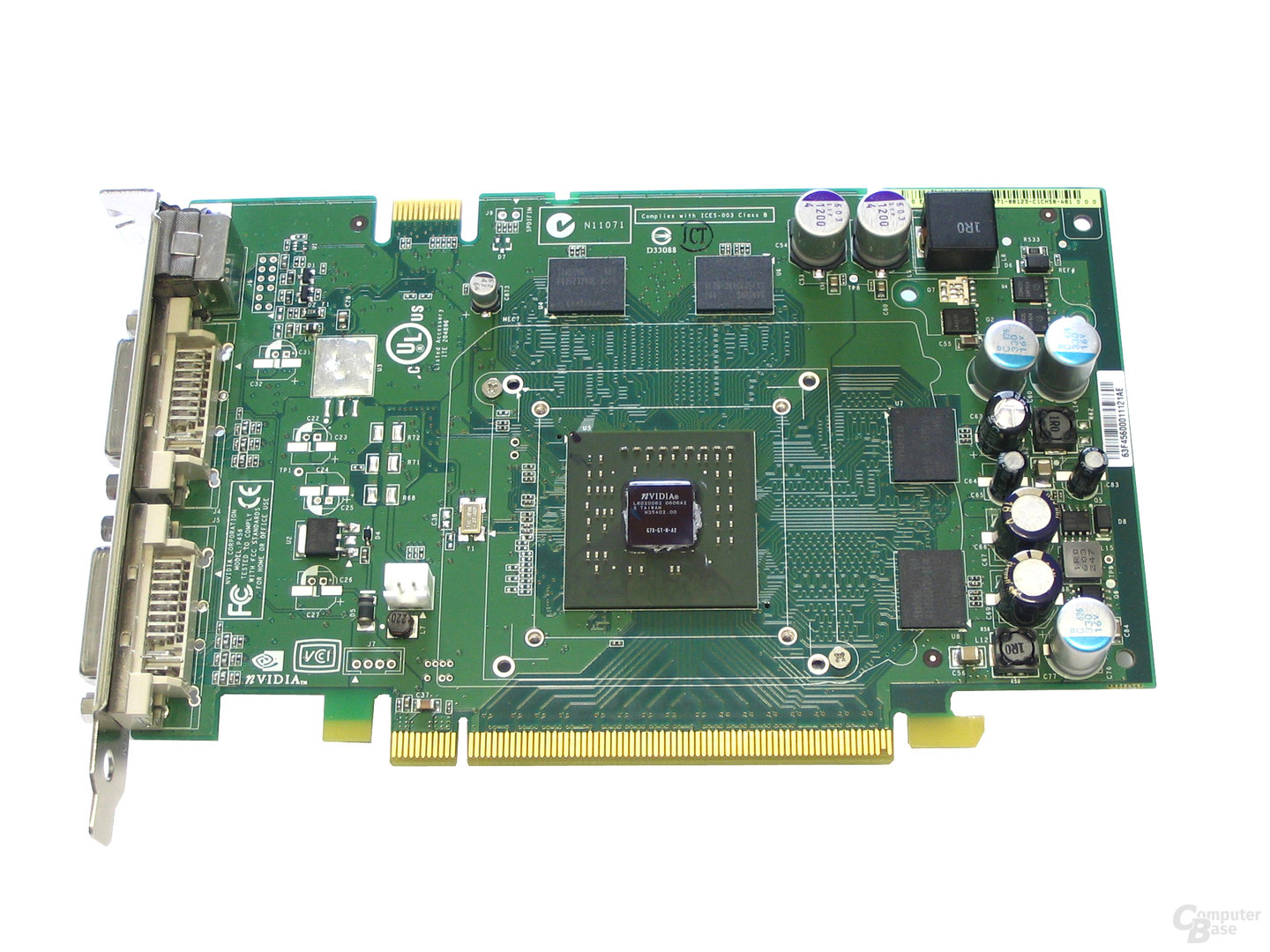 Asus EN7600GT Silent without cooler
Asus EN7600GT Silent without cooler  Asus EN7600GT Silent VRAM
Asus EN7600GT Silent VRAM 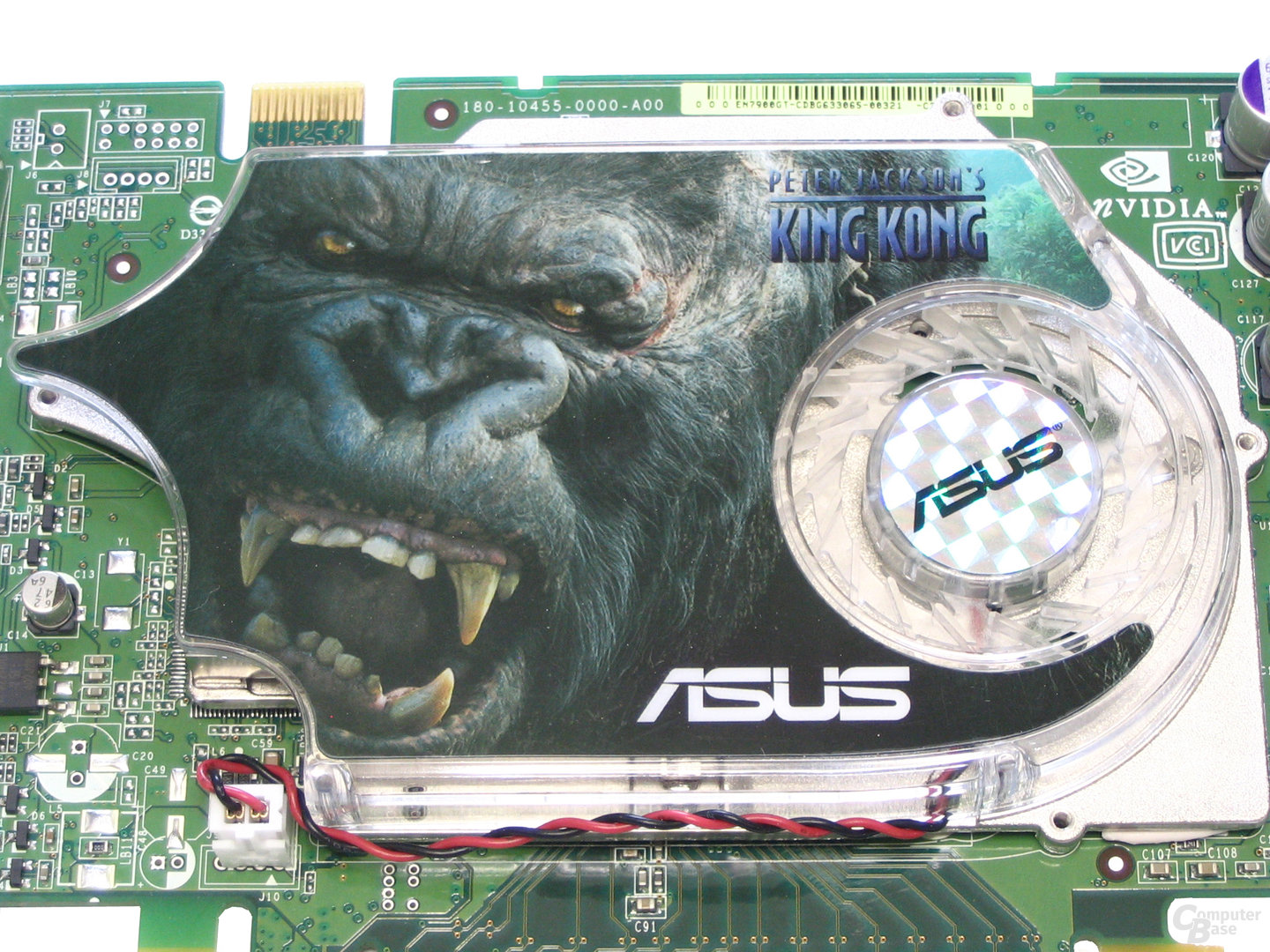 Asus EN7900GT TOP Kuehler
Asus EN7900GT TOP Kuehler 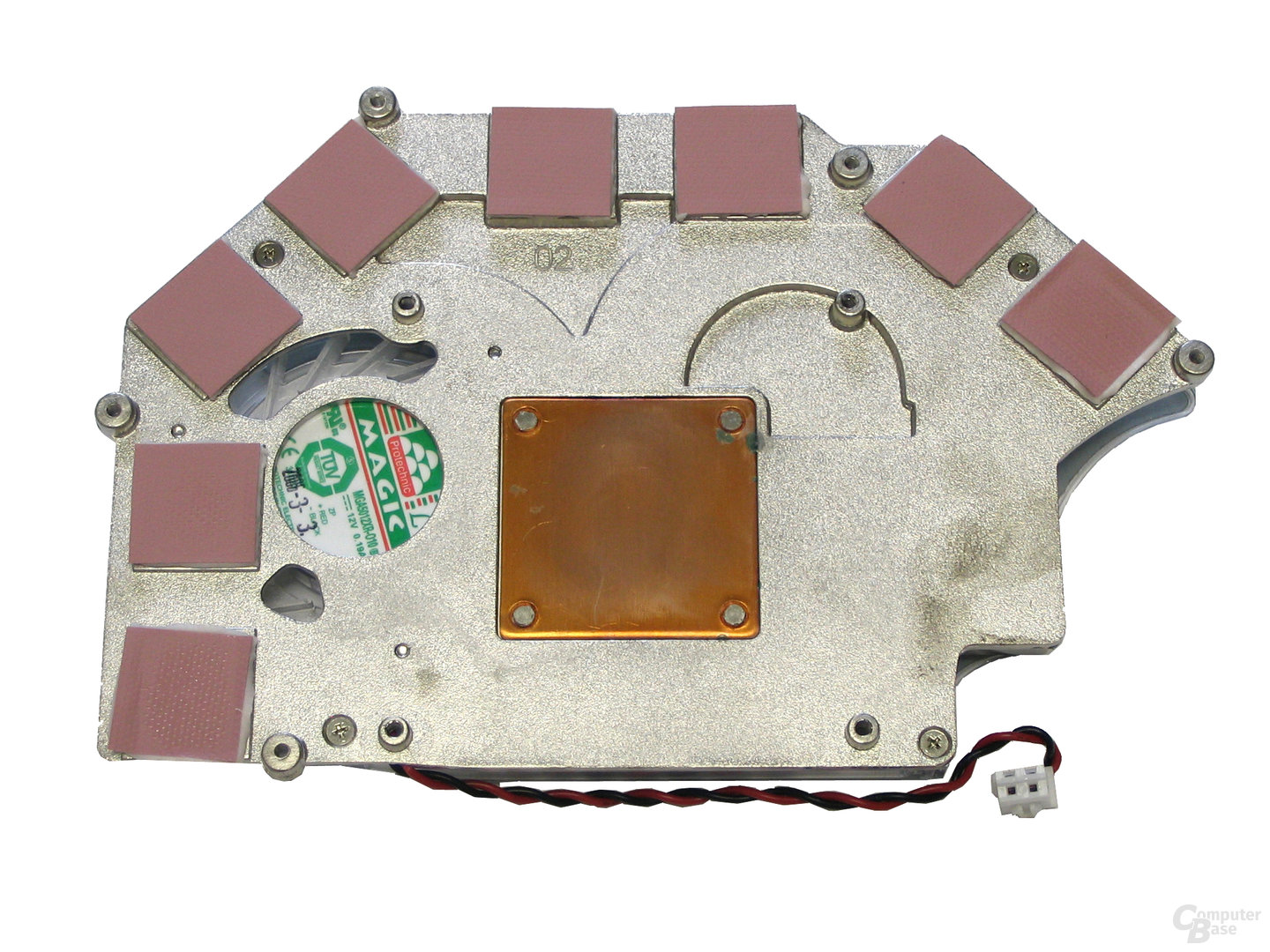 Kuehler Rueckseite
Kuehler Rueckseite There was nothing to complain about in terms of performance
The performance of the Asus EN7600 GT Silent corresponded exactly to that of a conventional GeForce 7600 GT, as the clock rates were identical. It was interesting that the built-in passive cooler ensured lower GPU temperatures than the reference cooler. In the benchmarks, the EN7900 GT TOP was able to achieve a performance increase of between 10 and 13 percent compared to the reference design. In addition, the volume was lower – but it was not recommended for users who wanted a quiet system. At 71 ° C, the GPU temperature of the graphics card was low even under load. With a functioning fan control, the volume could have been easily reduced to a comfortable level.
«Previous performance rating 1280x1024Performancerating 1600x1200Rating 1280×1024 4xAA/16xAFRating 1600×1200 4xAA/16xAFLVolumePower consumptionTemperatureOverclock Next »
- Performance rating 1280×1024 Unit: percent
- < li class = "chart__group">
- nVidia GeForce 7950 GX298,4
- nVidia GeForce 7900 GTX85,7
- ATi Radeon X1900 XTX84,9
- ATi Radeon X1900 XT82,8
- nVidia GeForce 7800 GTX 51278.4
- Asus EN7900 GT TOP73.9
- ATi Radeon X1800 XT72.8
- nVidia GeForce 7900 GT67.4
- nVidia GeForce 7800 GTX65.1
- ATi Radeon X1900 GT62.8
- nVidia GeForce 7800 GT56.3
- ATi Radeon X1800 XL53.9
- nVidia GeForce 7600 GT48, 6
- ATi Radeon X1800 GTO46,2
- nVidia GeForce 7600 GS32,7
- ATi Radeon X1600 XT30,3
- ATi Radeon X1600 Pro23,7
- ATi Radeon X1300 Pro16,8
-
- nVidia GeForce 7950 GX299,4
- ATi Radeon X1900 XTX81,6
- nVidia GeForce 7900 GTX80,6
- ATi Radeon X1900 XT78,1
- nVidia GeForce 7800 GTX 51273,1
- Asus EN7900 GT TOP67,2
- ATi Radeon X1800 XT66,2
- nVidia GeForce 7900 GT60,0
- nVidia GeForce 7800 GTX57, 3
- ATi Radeon X1900 GT53,9
- nVidia GeForce 7800 GT49,1
- ATi Radeon X1800 XL47,1
- nVidia GeForce 7600 GT41,6
- ATi Radeon X1800 GTO39,6
- nVidia GeForce 7600 GS27,8
- ATi Radeon X1600 XT25,8
- ATi Radeon X1600 Pro20,6
- ATi Radeon X1300 Pro13,6
-
- nVidia GeForce 7950 GX298,6
- ATi Radeon X1900 XTX74,1
- nVidia GeForce 7900 GTX74,0
- ATi Radeon X1900 XT71,2
- ATi Radeon X1800 XT64.6
- nVidia GeForce 7800 GTX 51264,5
- Asus EN7900 GT TOP60,1
- nVidia GeForce 7900 GT53, 7
- nVidia GeForce 7800 GTX48,8
- ATi Radeon X1900 GT48,2
- ATi Radeon X1800 XL44,9
- nVidia GeForce 7800 GT41,5
- ATi Radeon X1800 GTO37,9
- nVidia GeForce 7600 GT35.7
- ATi Radeon X1600 XT23,5
- nVidia GeForce 7600 GS22,4
- ATi Radeon X1600 Pro17,9
- ATi Radeon X1300 Pro12,8
-
- nVidia GeForce 7950 GX297,3
- ATi Radeon X1900 XTX72,5
- nVidia GeForce 7900 GTX70,2
- ATi Radeon X1900 XT69,8
- ATi Radeon X1800 XT61,3
- nVidia GeForce 7800 GTX 51260,9
- Asus EN7900 GT TOP56,0
- nVidia GeForce 7900 GT49,7
- ATi Radeon X1900 GT45, 1
- nVidia GeForce 7800 GTX44.7
- ATi Radeon X1800 XL40,9
- nVidia GeForce 7800 GT38,3
- ATi Radeon X1800 GTO34,7
- nVidia GeForce 7600 GT31,7
- ATi Radeon X1600 XT21,1
- nVidia GeForce 7600 GS19,6
- ATi Radeon X1600 Pro15,9
- ATi Radeon X1300 Pro9,3
- Idle (Windows):
- nVidia GeForce 7600 GS47,5 passive cooling
- Asus EN7600GT Silent47,5 passive cooling
- nVidia GeForce 7800 GTX 51248,0
- ATi Radeon X1600 XT48,0
- nVidia GeForce 7950 GX248,0
- nVidia GeForce 7900 GTX48,5
- ATi Radeon X1800 GTO48,5
- ATi Radeon X1300 Pro49,0
- ATi Radeon X1800 XL49,0
- nVidia GeForce 7800 GTX49,5
- ATi Radeon X1900 GT50,0
- ATi Radeon X1900 XTX50,5
- nVidia GeForce 7600 GT51,5
- nVidia GeForce 7800 GT51.5
- ATi Radeon X1800 XT52,0
- Asus EN7900 GT TOP55,5
- nVidia GeForce 7900 GT60,0
- Last:
- nVidia GeForce 7600 GS49,0 passive cooling
- Asus EN7600GT Silent49,0 passive cooling
- nVidia GeForce 7900 GTX50,0
- ATi Radeon X1800 GTO50,0
- nVidia GeForce 7800 GTX51,5
- nVidia GeForce 7800 GTX 51251,5
- ATi Radeon X1300 Pro55,0
- ATi Radeon X1900 GT55.0
- Asus EN7900 GT TOP55.5
- nVidia GeForce 7800 GT56.0
- ATi Radeon X1600 XT56,0
- ATi Radeon X1800 XT56,0
- nVidia GeForce 7950 GX256, 0
- ATi Radeon X1900 XTX58,0
- nVidia GeForce 7900 GT60.0
- ATi Radeon X1800 XL60.0
- nVidia GeForce 7600 GT61.0
- Idle (Windows desktop):
- nVidia GeForce 7600 GS149
- Asus EN7600GT Silent150
- nVidia GeForce 7600 GT153
- nVidia GeForce 7800 GT155
- ATi Radeon X1300 Pro156
- nVidia GeForce 7900 GT157
- ATi Radeon X1600 XT157
- ATi Radeon X1900 GT158
- Asus EN7900 GT TOP158
- ATi Radeon X1800 GTO160
- nVidia GeForce 7800 GTX164
- ATi Radeon X1900 XTX166
- ATi Radeon X1800 XL166
- nVidia GeForce 7800 GTX 512171
- nVidia GeForce 7900 GTX174
- ATi Radeon X1800 XT178
- nVidia GeForce 7950 GX2191
- Last:
- nVidia GeForce 7600 GS184
< li class = "chart__row">Asus EN7600GT Silent189
- ATi Radeon X1300 Pro191
- nVidia GeForce 7600 GT197
- nVidia GeForce 7900 GT202
- ATi Radeon X1600 XT204
- Asus EN7900 GT TOP206
- ATi Radeon X1800 GTO211
- nVidia GeForce 7800 GT219
- ATi Radeon X1800 XL223
- ATi Radeon X1900 GT246
- nVidia GeForce 7900 GTX251
- nVidia GeForce 7800 GTX252
- ATi Radeon X1800 XT264
- nVidia GeForce 7800 GTX 512272
- ATi Radeon X1900 XTX281
- nVidia GeForce 7950 GX2281
- Idle chip:
- nVidia GeForce 7800 GT40
- nVidia GeForce 7900 GTX41
- nVidia GeForce 7800 GTX 51243
- nVidia GeForce 7900 GT45
- nVidia GeForce 7800 GTX46
- ATi Radeon X1600 XT47
- Asus EN7900 GT TOP47
- ATi Radeon X1800 GTO49
- ATi Radeon X1900 XTX49
- Asus EN7600GT Silent51 flat cooler: 52
- ATi Radeon X1800 XL53
- nVidia GeForce 7600 GT54
- nVidia GeForce 7600 GS56
- ATi Radeon X1900 GT57
- nVidia GeForce 7950 GX259
- ATi Radeon X1800 XT63
- ATi Radeon X1300 Pro68
- Last – Chip:
- nVidia GeForce 7800 GT59
- nVidia GeForce 7900 GTX65
- nVidia GeForce 7900 GT67
- ATi Radeon X1800 GTO68
- ATi Radeon X1800 XL71
- Asus EN7900 GT TOP71
- ATi Radeon X1600 XT72
- nVidia GeForce 7800 GTX 51275
- Asus EN7600GT Silent76 flat cooler: 79
- nVidia GeForce 7800 GTX80
- nVidia GeForce 7600 GT81
- nVidia GeForce 7600 GS86
- ATi Radeon X1900 GT86
- ATi Radeon X1800 XT87
- nVidia GeForce 7950 GX288
- ATi Radeon X1900 XTX91
- ATi Radeon X1300 Pro98
- Last – back of the chip:
- ATi Radeon X1800 GTO56
- ATi Radeon X1800 XL56
- ATi Radeon X1600 XT57
- Asus EN7900 GT TOP57
- nVidia GeForce 7600 GT58
- nVidia GeForce 7900 GT58
- nVidia GeForce 7800 GT60
- nVidia GeForce 7900 GTX66
- nVidia GeForce 7800 GTX 51271
- nVidia GeForce 7600 GS72
- nVidia GeForce 7800 GTX73
- ATi Radeon X1800 XT73
- ATi Radeon X1300 Pro75
- ATi Radeon X1900 GT76
- Asus EN7600GT Silent76 flatter Cooler: 77
- ATi Radeon X1900 XTX81
- nVidia GeForce 7950 GX282
- Quake 4 – 1600×1200 4xAA/16xAF:
- EN7900GT TOP – overclocked (560/830) 48.7
- EN7900GT TOP – Standard (520/720) 43.2
- EN7600GT Silent – overclocked (620/870) 31.4
- EN7600GT Silent – Standard (560/700) 25.5
- HL2: Lost Coast – 1600×1200 4xAA/16xAF:
- EN7900GT TOP – overclocked (560/830) 38.2
- EN7900GT TOP – standard (520/720) 34.9
- EN7600GT Silent – Overclocked (620/870) 23.2
- EN7600GT Silent – Standard (560/700) 19.5
- Fear – 1600×1200 4xAA/16xAF:
- EN7900GT TOP – Overclocked (560/830) 37.0
- EN7900GT TOP – Standard (520/720) 33.0
- EN7600GT Silent – Overclocked (620/870) 23.0
- EN7600GT Silent – Standard (560/700) 18.0
In the test, further overclocking the EN7900 GT TOP resulted in an additional 9 to 13 percent performance. The EN7600 GT Silent had even greater reserves: With a clock rate of 620/870 MHz (GPU/memory) it worked between 19 and 28 percent faster than in the delivery state.
Conclusion
The EN7600 GT Silent was an attractive offer at a price of 180 euros. For a surcharge of around 15 euros, customers received a silent and at the same time well-cooled graphics card that had sufficient performance for most players. The conclusion to the EN7900 GT TOP looked less positive. Although it worked faster and a little quieter than the GeForce 7900 GT reference design, it still didn't do justice to the price of 285 euros due to the high volume. Customers could find significantly better and quieter cooling solutions with the GeForce 7800 GTX (512) and 7900 GTX, although these graphics cards were more expensive. Another alternative were coolers from third-party suppliers, which were much quieter.
In the “Tested 15 years ago” category, the editorial team has been looking into the test archive every Saturday since July 2017. The last 20 articles that appeared in this series are listed below:
- The “gamer cube” that only ventilated via the power supply
- Nvidia's double decker alias GeForce 7950 GX2
- Nvidia's nForce 500 for AMD's AM2 socket with DDR2 RAM
- The best Radeon X1900 XTX came with a Zalman cooler
- PCIe x8 versus PCIe x16 for multi-GPU systems
- ATi's X1900 GT bit its teeth on Nvidia's 7900 GT
- PhysX accelerator for 299 euros from Ageia
- The GeForce 7600 GS was a stunner for 125 euros
- HTPC case from Lian Li and Silverstone
- The GeForce 7900 GTX in 90 nm and with a higher clock rate
- Creative Sound Blaster X-Fi for more audio quality and FPS
- Silentwinter got the Athlon 64 going with RAM-OC
- ATi's all-in-wonder Radeons with TV tuner
- Entry-level graphics cards were loud or slow
- Noctua's first CPU coolers NH-U9 and NH-U12
- The GeForce 7800 GS breathed life into AGP again
- ATi's Radeon X1900 XTX was fast, hot and loud
- Dual-core CPUs from AMD and Intel in a duel
- In the second attempt, ATi CrossFire was better
< li> Intel's Pentium EE 965 was faster and more economical
Even more content of this kind and many more reports and anecdotes can be found in the retro corner of the ComputerBase forum.

